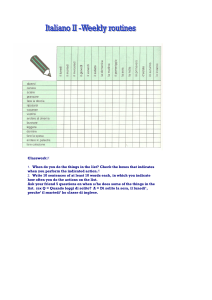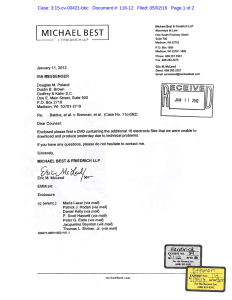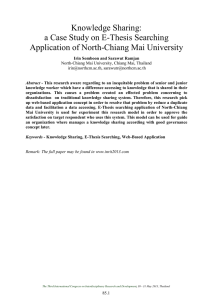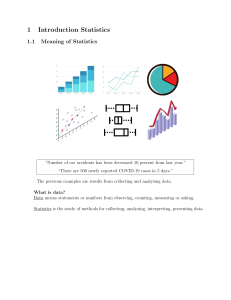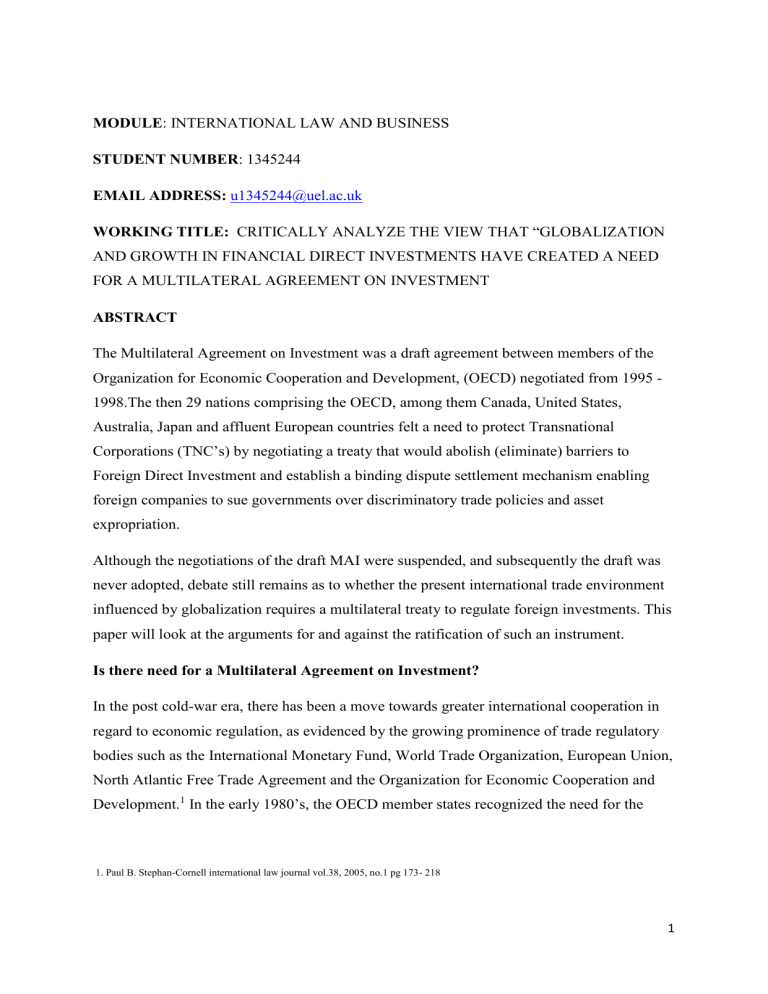
MODULE: INTERNATIONAL LAW AND BUSINESS STUDENT NUMBER: 1345244 EMAIL ADDRESS: u1345244@uel.ac.uk WORKING TITLE: CRITICALLY ANALYZE THE VIEW THAT “GLOBALIZATION AND GROWTH IN FINANCIAL DIRECT INVESTMENTS HAVE CREATED A NEED FOR A MULTILATERAL AGREEMENT ON INVESTMENT ABSTRACT The Multilateral Agreement on Investment was a draft agreement between members of the Organization for Economic Cooperation and Development, (OECD) negotiated from 1995 1998.The then 29 nations comprising the OECD, among them Canada, United States, Australia, Japan and affluent European countries felt a need to protect Transnational Corporations (TNC’s) by negotiating a treaty that would abolish (eliminate) barriers to Foreign Direct Investment and establish a binding dispute settlement mechanism enabling foreign companies to sue governments over discriminatory trade policies and asset expropriation. Although the negotiations of the draft MAI were suspended, and subsequently the draft was never adopted, debate still remains as to whether the present international trade environment influenced by globalization requires a multilateral treaty to regulate foreign investments. This paper will look at the arguments for and against the ratification of such an instrument. Is there need for a Multilateral Agreement on Investment? In the post cold-war era, there has been a move towards greater international cooperation in regard to economic regulation, as evidenced by the growing prominence of trade regulatory bodies such as the International Monetary Fund, World Trade Organization, European Union, North Atlantic Free Trade Agreement and the Organization for Economic Cooperation and Development.1 In the early 1980’s, the OECD member states recognized the need for the 1. Paul B. Stephan-Cornell international law journal vol.38, 2005, no.1 pg 173- 218 1 removal of regulatory barriers for cross- border investments due to the evolution of multinational enterprises and the increasing complexity of their financing through offshore tax jurisdiction. They drafted the prospective MAI largely in secret, but the negotiations had to be suspended and it was never ratified. The adoption of the draft MAI was thwarted by a spirited campaign by the Media and NonGovernmental Organizations (NGO’s), environmentalists and trade unions, who argued that the MAI would compromise the sovereignty of the less powerful and poor Developing Countries (DC’s) and Least Developing Countries (LDC’s).They argued that the MAI would grant the Multinational Companies (MNC’s) the leeway to “ride roughshod” or threaten environmental protection rules. They also claimed that the agreement would also compel LDC’s to lower labour standards in order to attract foreign investment. There was also lack of consensus among the Member states as stipulated in OECD procedures, with the host country (France) retracting on its adoption. The purpose of the proposed MAI was to develop multilateral rules that would ensure that international investment was governed in a more systematic and uniform way between states. There are also a host of Global Governance Regimes and Regional Trade Agreements that regulate in all spheres of human activity with emphasis on economic management. International Governance Regimes include international bodies such as the United Nations (UN), International Criminal Court (ICC), The World Bank (WB) and The International Monetary Fund (IMF) EU (European Union), NAFTA (North American Free Trade Agreement). But with the exception of The World Trade Organization, largely due to its rules- oriented Dispute Settlement Mechanism, they are deemed to have limited power to enforce compliance by states or MNC’s in the sphere of international trade governance. Other agreements in the WTO dealing with trade regulation include Trade-Related Investment Measures (TRIMS), General Agree on Trade and Services (GATS) and Trade Related Aspects of Intellectual Property Rights (TRIPS). In view of the above inclusive and broad coverage of all areas of International Trade, it begs the question as to what additional features a MAI can add on to global trade regulation to justify the need by the industrialized nations for guarantees for global trade. The contention is that none of these specifically dealt with the governing of foreign direct investment, and the numerous Bilateral Investment Treaties and Regional Trade Agreements were highly 2 contradictory in their laws and insufficient in guaranteeing market access to the emerging economies especially of Latin America and East Asia.2 The growing importance of FDI is one of the reasons why a MAI is required. Capital movement has impact on both the capital exporting state (CES) and the capital importing state (CIS), with benefits such as increased market access and improved competition with the availability of cheaper goods. The CIS also benefits from improved access to technology and strategic alliances with foreign partners, and this can improve the CIS’s economy. Foreign Direct Investments face certain Regulatory restrictions such as; foreign equity limitations, screening or approval mechanisms, restriction on the employment of foreigners as key personnel and, operational restrictions which can be overcome with a binding MAI. Another reason why it is imperative to have a multilateral agreement on investments is because foreign investors need transparent and predictable rules on which they can operate, which must include legal security (Zdenek 1998). This will create a secure environment for investment, in order to attract FDI and foreign capital. This is line with the basic principles of the WTO of non- discrimination and National Treatment, and Most Favoured Nation clause (GATT Art I).This would enhance the free flow of capital with the free trade. But critics of globalization and liberalization argue that states have lost control over local economies, with the power shifting to global corporations, and that free flow of FDI is not necessarily desirable by all developing countries. It is the basis for their opposition to the establishment of an international investment treaty. According to Kobrin 3 “the MAI was to provide the framework for international investment what the GATT provided for international trade,” that is, the elimination of discriminatory treatment in international commerce. He notes that the Global Stock of FDI quadrupled between 1982 -1994, with annual flows of cross-border investment reaching $ 350 billion in 1996, 4 prompting industrialized countries to focus on the governance of international investments by instituting a MAI to replace the estimated BIT’s in existence then, and consolidating the overall regulatory framework for investments. 2. Andrew Walter,” Globalization and Policy Convergence: The Case of Direct Investment Rules” in R. Higgott and A.Beiler, Non –State Actors in the Global Economy. London Routledge, 1999] 3. Kobrin, S .J, “The MAI and the clash of globalization,” foreign policy, 1998 no. 112, p.97 4. ibid 3 The proposed Multilateral Agreement on Investment’s main objective was the creation and protection of stable investment conditions in the international trading arena. Jeffrey Lang, the Deputy US Trade Representative and co- leader of US Delegation to the OECD Negotiations of the MAI] stated that, “We intend for the MAI Agreement to provide a broad multilateral framework for international investment, with high standard for the liberalization of investment regimes, investment protection and effective dispute settlement.”5 Lang envisioned a MAI that would; - first, “lock-in” current MFN and National Treatment to the greatest extent possible, and secondly, improve the current investment climate among current OECD Members States and future MAI signatories. A third purpose of the proposed MAI was to broaden acceptance of international investment norms, and, the fourth to provide clear, predictable and transparent treatment of US investors. OECD Member states and nonOECD states that sought accession were to ensure investors have access to markets. Nations were to repeal all barriers to trade and business regulations that violated MAI provisions. The expropriation clause in the draft accord would give the right of investors to sue governments, and enable compensation to corporations arising from proven unfair or discriminatory investment conditions causing loss of profit. Another argument for the need of foreign investment regulation is so as to achieve policy consistency. This would incorporate the salient features of the numerous Bilateral and regional trade agreements, and reduce the instances of conflicting regulation with regard to investments. Expropriation or the regulatory taking clause was one of the most contested clauses included in the draft MAI. Expropriation can either be the physical confiscation of property of property and assets, or the introduction of regulations which could amount to takings if it results in the loss of profit in the MNC’s. Expropriation is recognized under customary international law as a legal option for the host state when the state meets three principle requirements, namely; that it should be for public purpose; that it should be nondiscriminatory; and that compensation should be promptly paid to the investor in mutually acceptable terms. 5. Keynote address, Cornell International Law Journal, vol. 31, 1998, pg 455-466 4 The inclusion of the expropriation clause for both regulatory and physical taking of property was so as to protect foreign investors and limit the rights of states to take property by imposing certain prerequisites or preconditions for foreign investments entering their country. It was intended to establish standards for the manner in which host states can justify the taking of investors’ property. The draft MAI included appropriate or just compensation based on the market value or use of the Hull formula in case of loss of profit arising from regulatory takings. The recent process policy liberalization in many developed and developing country has greatly affected fiscal, infrastructural and financial policies of most nations. Therefore investors need protection to do business and to secure their investments abroad, and the ideal framework would be an MAI to guarantee stability in investment even with a change in other domestic laws. In order to minimize the risk of doing business, investors are most likely to choose to transact in countries where their business is most secure. When the details of the MAI leaked to the media, there was a global uproar led by the Media, Non Governmental Organization’s and the civil society, resulting in a spirited campaign opposing the adoption of the accord. This led to a thorough scrutiny of the issues and topics under discussion and a raging criticism compounded by the fact that the discussions had been held in secret. There was also lack of consensus among the OECD members on some of the provisions/ issues/ topics being negotiated. For instance, United States objected to the Regional Economic Integration Organization (REIO) Clause put forward by members of the EU arguing that it would discriminate and disadvantage the US if it wished to trade with former East Bloc European Union countries. The MAI was therefore not adopted, and the negotiations suspended. The NGO’s, scholars, other non- state actors and even member states of the OECD denounced the MAI, and alleged it was a ‘major and immediate’ threat to democracy, sovereignty, human rights, the environment and economic development. Among the provisions of the draft agreement was the ban on performance requirements, and the expropriation clause. The expropriation clause bars any law or requirement or its equivalent that impedes the investors right to make profit, and the nationalization of investor’s assets by the host country. It was argued that the adoption of this clause would have an adverse effect on national legislation, as countries would to repeal and reformulate their national governing rules in order to accommodate the more wealthy international 5 players. This was regarded as a threat to the sovereignty of the Developing Countries who were establishing themselves after a prolonged period of colonial rule. The ability to formulate and enforce legislation is one of the hallmarks of statehood. The Secretary - General of OECD Donald Johnson 6 argued that the Agreement “would not interfere with the freedom governments to implement their own policies concerning Law and Environmental Standards as long as these standards were not more stringent for foreign investors.” He further assured that the MAI would not eliminate the authority of the domestic courts, tribunals and regulatory authorities over foreign investors and their enterprises. The MAI would not immunize foreign investors from domestic laws. Further, He reiterated that countries were not required to lower labour and environmental protection standards to attract foreign investment. The detractors of the MAI argued that workers rights and the environment would be greatly compromised by the adoption of the MAI, since any laws for environmental protection and labour laws, especially by the LDC’s who are the main source of raw materials and cheap labour would be deemed limiting the investors’ right to profit and would therefore be prohibited by the treaty. Those opposed to the draft MAI alleged that codification of the draft would have a negative effect on labour and environmental standards, and would dilute national legislation for the protection of the environment. The antagonists of the MAI cited the US based Ethyl Corporation case against the Canadian Government 7 in which the US claimed that Canada had violated NAFTA commitments. Canada had banned the use of a fuel additive produced by Ethyl Corporation due to health and environmental reasons. Ethyl argued that the Canadian environmental laws amounted to regulatory takings and enforced/ espoused performance requirements. They claimed that enforcing this law was in violation of the National Treatment clause. In the end, Canada and to repel this law and pay compensation to Ethyl for material injury. In this context, the MAI appeared to establish a new body of universal investment laws to guarantee corporations excessive powers to takeover and undertake financial operations all over the world without regard to state sovereignty, requiring countries to change their laws to accommodate the wishes of other nations with the performance clause. 6. European Report Feb., 1998 7. Ethyl Gasoline Corp.v. United States 309 US 436 6 Another basis for the opposition to the multilateral agreement was that it would adversely affect the least developed countries. There was alleged that the implementation of the MAI would result in a “race to the bottom” among countries willing to lower their labour their labour and environmental standards to attract foreign investment. Martin Khor, the director of the Malaysian –based Third World Network argued that, “The economies of most developing countries were shaped to the advantage of foreign countries and financial institutions and therefore local firms required special treatment for a longer time before they can compete on more balanced terms with large companies”. According to OECD Statistics 8 in 1998, OECD Member States collectively accounted for a large part of FDI’s worldwide; 85% outflows and 60% inflows. Hence they had a large stake in the protection of their investments abroad and attempted to guarantee this by spearheading the formulation of the rules to govern international investment, hence their attempt at drafting the MAI. The MAI negotiations were an attempt to consolidate and complete the existing OECD instruments such as, the 1961 Codes of Liberalization of Capital Movement,(promoting liberalization of international trade in goods and services and progressive freedom of capital movement), and the 1976 International Investment and Multinational Enterprises (a policy commitment by OECD member governments to provide an open and transparent environment for international trade and , multinational enterprises’ positive contribution towards economic and social progress),9 which have helped promote international and economic cooperation for many years. There is a general consensus that the proliferation of Foreign Direct Investment and regional trade liberalization have led to free trade and facilitated economic development. Scholars argue that the arguments against the establishment of a multilateral framework for the regulation of foreign investment are usually the arguments against globalization and its effects such as the liberalization of global markets. 8..http://www.oecd.org/corporate/mne/statistics 9. oecd.org/ 7 Globalization is the process by which businesses and organizations develop international influence and start operating on an international scale;-moving investment funds beyond domestic and national markets, increasing the interconnectedness of different markets. Globalization is often broadly defined as “networks of interdependence that span intercontinental distances” (Keohane and Nye 2000a, 105). Globalization has considerably shaped world economy in the past century, and has had a great impact on individuals, communities, and the environment. Globalization and liberalization have impacted on the democratic process by influencing the way in which laws are formulated to adhere or conform to international norms. International market liberalization has prompted a dramatic growth in Foreign Direct Investments, a key driver of international economic integration, which additionally provides stability, while promoting economic development. Borensztein et al (1998) 10 argues that FDI’s contribute to economic growth by stimulating technological progress rather than by increasing total capital accumulation In order to “convince the sceptics” Drabek (1998) asserts that the positive aspects of the multilateral agreement should outweigh the negative ones.11 According to the WTO report (1996), there is recognition of the growing importance of FDI in international economic relations, with FDI exceeding official assistance as the most important component of external financial flows. Some of the benefits of FDI are increased market access and market channels, improved skills, and augmentation of access to technology, and a growth in domestic savings and investments. Developed as well as Developing Countries are all confronted with the challenge of attracting and exploiting the gains of international investments represented by Foreign Direct Investment and Portfolio Investment. Foreign Direct Investment presents a higher risk for the investor because it entails (involves) long term direct or indirect investment and participation by way of management, technology transfer and capital, and thus greater challenges for the investor to strike the right policy balance to generate better returns. In his Keynote address, Jeffrey Lang, the then Deputy US Trade Representative and co-leader of the US Delegation to OECD Negotiations on the MIA was of the opinion that although US 10. E. Borensztein et al, international economics, 1998, vol.45 ,pg 115 -135 11. Zdanek Drabek, A Multilateral Agreement on Investment: Convincing the Sceptics, WTO Staff Working Paper ERAD-98-05, 1998 8 foreign investments were extensively covered and protected by the existing Bilateral Investment Treaties (BIT’s) and the NAFTA (North American Free Trade Agreement), there was further need to have a treaty that would “lock-in” and guarantee the current favourable treatment to the greatest extent possible.12 With globalization and the liberalization of world trade emerge challenges to global governance which can create uncertainty in global trading, with an adverse effect on financial investments. Such challenges include; climate change (global warming), the threat of violence (terrorism), pandemics (HIV/AIDS), Fiscal Markets meltdown ( 2008), dangers of nuclear weapons, large scale Humanitarian crises and conflict , and failed states. Uncertainty and unpredictability is unfavourable for any MTC’s seeking to invest in these regions, because trade requires the assurance of the protection of the investments in the foreign countries for it to thrive. For the management of these problems, cooperation between governments and non-state actors is imperative, with emphasis on the means of securing compliance of both states and non-state actors’ to the rules. Historically, there have been many attempts to protect FDI with the use of bilateral friendships and treaties. Within the last two decades, BIT’s have greatly increased in number; with UNCTAD statistics of 2012(pg 84) showing a total of 3164 BIT’s and FTA’s involving the regulation of FDI. Currently, FDI flows in both directions; between developed and developing countries. In addition, outward FDI was $ 2.2 trillion in 2007 and still growing thus warranting an international standardized set of rules for FDI. The numerous and similar BIT’s could be consolidated and harmonized into one standardized regulatory framework. At the end of the WWII, United States initiated negotiations for the creation of the International Trade Organization (ITO) as an investment Platform. Failure to ratify the International Trade Organization (ITO) treaty left the GATT, now WTO as the only regulatory instrument dealing with trade issues, with various fragmented BIT’s. This was during the era of decolonization during which BIT’s were signed between Developed countries and newly independent Nations keen to attract investment while protecting their newly won independence. The obligation to protect FDI fell on the developed countries (CIS), and was viewed by the developing countries as intrusion and foreign control of their means of 12. Cornell International Law Journal vol.3, 1998, no.1 pg 455- 466 9 production (Anders 2013).13 The evolution towards broader Regionalization as evidenced by the expansion of the EU validates the need for a broad multilateral order. Anders, a leading specialist in post communist economic transformation, 14 argues that there is need for a Multilateral Agreement on Investment framework to mediate in view of the growth and expansion of state capitalism and Sovereign Wealth Funds (SWF’s) especially from China and Russia, both geographically large markets. China and Russia want to invest abroad but are viewed with suspicion because of their political orientation (both are communist countries). The capital importing states (CIS) that are recipient of these SWF’s question the transparency and objectives of these SWF’s due to concerns of national security (Truman 2010). A MAI Framework is thus needed to regulate and facilitate FDI, considering the interests of state investors and national security concerns in the recipient countries. The MAI negotiations attracted negative debate from civil society and both private and public sectors and had to be discontinued. Any future negotiations for International Investment Agreements (IIA’s) will be influenced by this experience. The proponents of the performance clause in the MAI called for nations to allow for greater market access by repealing all barriers and a “roll back” of existing laws not in accordance with the draft MAI, and further to refrain from passing new laws that contradict it. (Kobrin 1998Government measures, for instance, domestic production requirements, tax incentives and export requirements would be tantamount to protectionism and lead to investment wars similar to the trade wars of the 1930’s (Bergsten 1974). These “beggar thy neighbour policies” were prevalent in response to United States’ adoption of the Smoot – Hawley Tariff of 1930 which was formulated for the protection of agricultural production by the American farmers. According to Graham (Graham 2006), government measures should not discriminate against foreign-owned enterprises, except for the protection of national security.15 13. Anders Aslud, “The World Needs a Multilateral Investment Agreement, Policy Brief, Petersen Institute for International Economics, 2013 14. ibid 15. Kobrin S.J, “The MAI and the clash of Globalization,” Foreign Policy, (1998) no.112, p 97. 10 Those opposed to the MAI claimed that a ban on performance requirements and the expropriation clause provisions would put all business above the regulation of municipal governments, placing Multinational Corporations beyond the reach of national and local economic governance. It would limit the ability of local and national legislation in the areas of health, workers’ rights, environment and natural resources. This would lead to a threat to national sovereignty and democracy, as the LDC’s would have to alter and formulate legislation to accommodate the more prosperous nations Performance requirements (such as local content, local manufacture and technology transfer requirements) are development strategies and economic policies employed by developed nations to achieve industrialization and economic growth (Malhotra 2004), and prohibition, LDC’s argue, would impede their economic development. The opponents of a MAI argued that the ratification of the treaty /MAI would compromise the sovereignty of states, and would influence the drafting of legislation. The US Ethyl corporation v Canada case was cited as an example of ways in which foreign MTC’s could influence domestic legislation. In the rulings, Canada was forced to repeal the offending measure and pay compensation to Ethyl despite the fact that the laws had been enacted as a means of environmental protection. The US.V, EU beef- hormones case 16 involving the Agreement on the application of Sanitary and Phyto Sanitary measures (SPS Agreement) is an example of how conflicting regulation can pose a dilemma in the area of trade dispute settlement. 16. WTO/DS320 11 Recommendations The United Nations Committee on Trade and Development (UNCTAD) serves as the focal point within the United Nations Secretariat for all matters related to foreign direct investment and transnational corporations. In the aftermath of the collapse of the MAI talks, UNCTAD commissioned research on the need and viability of an international investment treaty, with a view to assisting the Less Developed Countries (LDC’s) to fully participate as effectively as possible in international investment rule making at the bilateral, regional, plurilateral and multilateral levels. This will be achieved by capacity building seminars, regional symposia, training courses, dialogues between negotiators and groups of civil society.17 Sauvant K. P et al 18 the lead author of the paper recognizes codification of investment law as a powerful and integral part in economy and commerce, and proposes for the participation of all states in its formulation. To overcome some of the impediments put forward by the critics, Anders Aslud (2013)19proposes that a future MAI should address the following issues; First, it should be clear about the treatment of investors with special emphasis on the MFN clause and the National Treatment clause, and lay down the guidelines for investor protection, preferably compensation at full market value in case of expropriation. Dispute settlement redress stipulated in the draft accord should include state- to -state procedures as well as investor- to state procedure, bearing in mind that it is not actually the states that own the businesses but mostly investors. Aslud (2013) 20 advocates that a future MAI should include corporate social responsibility and environmental issues. The rights and obligations of states as investors [SWF’s] need to be clarified which would be essential to overcome bureaucratic resistance, for instance, that experienced by Chinese High-Tech companies and Russian energy companies that are state 17. UNCTAD, IIA Issues Paper Series, Taking of Property (2000) 18. ibid 19. Anders Aslud, “The World Needs a Multilateral Investment Agreement, Policy Brief, Petersen Institute for International Economic, 2013 20. ibid 12 owned investing in the global trading arena. Additionally, state owned companies should be required to be more transparent and clearly regulated. Since the failure to conclude the draft MAI was due in part to the prevailing ideological outlook at the time, and also the choice of home organization [OECD], Aslud (2013) suggests that G-20 nations should lead the negotiations, but that they should be carried out under the umbrella of the WTO. It should be a plurilateral agreement within the framework of the WTO or the ICSID. Given that the WTO already harbours such other similar agreements it should not be problematic. Relevant examples include Information Technology Agreement, and the Government Procurement Agreement. A suitable international commercial agreement should complement the prior achievements of BITS and FTA’s and provides a floor of standards and obligations for the settlement of trade disputes. The Financial Times London (1998) hailed the MAI as an important contribution to the new international architecture needed to cope with financial turbulence of increasing trade integration. MAI was to include three key areas of investment rule making, namely; investment protection, investment liberalization and binding dispute settlement (European Report Feb 1998). Zdenek Drabek in his paper, “....convincing the sceptics” Drabek (1998) states that “the recent currency turmoil and the widespread concerns about the volatility of international capital inflows have provided an impetus to the debate on the desirability of a multilateral agreement on foreign investment due to spread of regionalism and the role of foreign investment and multilateral enterprises Developed Countries sort to integrate the LDC’s into the multilateral trading system, largely regarded as marginalized by globalization. But although an investment treaty does not guarantee expansion in FDI, it can increase transparency of government commitments and improve conditions for access of FDI. Foreign investors need transparent and predictable rules on which they can operate and this must include/ incorporate legal security, (Drabek 1998) National legislation is usually not sufficient to guarantee amble security to foreign investors since there is risk of inconsistent rules entrenched in various /different agreements. The procedures and mechanisms for the settlement of trade disputes should be clearly spelt out, and prospect of investor – state arbitration explored. 13 In conclusion, we must acknowledge that it is impossible to roll back the effects of globalization which had led to substantial growth in international trade. This encompasses trade in goods as well as services, portfolio investments and Foreign Direct Investment. This growth has been largely beneficial in that it has helped boost economies in the developing and less developed countries, and as resulted in the transfer of technology and skills in the regions where the investments are situated. To ensure the security and protection required for commercial growth, an international investment agreement would be beneficial especially by stipulating the regulatory framework for foreign direct investments. It should have a broad framework to tackle the contentious issues pointed out in the UNCTAD (1998) IIA paper series including labour and environmental laws, cultural exception and arbitration of trade disputes. The accord should revisit the controversial performance requirement and expropriation clauses, and address investment protection with is fundamental for economic stability and growth. REFERENCES Michael Trebilcock and Robert Howse: The Regulation of International Trade (Routledge Great Britain 2005) Margaret P. Karns and Karen A. Mingst: International Organisations: The Politics and Processes of Global Governance. (Portland: Lynne Rienner 2009). Walter Mattli and Woods, N: The Politics of Global Regulation. (New Jersey: Princeton University Press 2009). Joseph Stiglitz: Making Globalization Work: The Next Steps To Global Justice, (London: Penguin books 2006) Kenneth Abbott and David Snidal, International organizations: “hard and soft law in international governance”, http://www.wto.org/ - accessed on 20-12- 2014 http://www.oecd.org/corporate/mne/statistics.htm - accessed on 15-12-2014 http://www.oecd.org/statistics/ - accessed on 15.12.2014 http://www.naftanow.org/ - accessed on 28-12-2014 http://www.citizen.org/nafta accessed on 08-12-2014 14 www.oecd.org/ -accessed on 18-12-2014 Ray Dennis .M, “The Multilateral Agreement on Investment; implications for Entrepreneurship and New Venture Development”, Globalization, vol.7 no.1 (2008) p 146. Walter A, NGO’s. “Business, And international Investment: The Multilateral Agreement on Investment, Seattle and Beyond”, Global Governance, vol.7 no.1 (2001) p51. Kamal Malhotra, “Will a Trade and Investment Link in the Global Trade Regime Be Good for Human Development,” The European Journal of Development Research,(2004) vol.16, no.3, pp 716 -736. M Daly, “some taxing questions for the multilateral agreement on Investment, world economy,1997, vol.20, no.6, p 787 -808 UNCTAD IIA Issues Paper Series, UNCTAD series on issues in international investment agreement, Geneva 2000. Authors Karl P. Sauvant, Pedro Roffe et al Kobrin, S .J, “The MAI and the clash of globalization,” foreign policy, 1998 no. 112, p.97 Andrew Walter,” Globalization and Policy Convergence: The Case of Direct Investment Rules” in R. Higgott and A.Beiler, Non –State Actors in the Global Economy.( London Routledge, 1999) Paul B. Stephan-Cornell international law journal vol.38, 2005, no.1 pg 173- 218 Jeffrey Lang: Keynote address, Cornell International Law Journal, vol. 31, 1998, pg 455-466 European Report Feb., 1998 . E. Borensztein et al, international economics, 1998, vol.45 ,pg 115 -135 Zdanek Drabek, A Multilateral Agreement on Investment: Convincing the Sceptics, WTO Staff Working Paper ERAD-98-05, 1998 Cornell International Law Journal vol.3, 1998, no.1 pg 455- 466 UNCTAD, IIA Issues Paper Series, Taking of Property (2000) Anders Aslud, “The World Needs a Multilateral Investment Agreement, Policy Brief, Petersen Institute for International Economic, 2013 15 Jonquieres de, G., & Kuper, S. (Push to keep alive effort to draft global investment rules OECD MINISTERS FAIL TO SET DATE FOR MAI AGREEMENT AFTER MISSING TWO DEADLINES: Financial Times Apr 1998 Retrieved from http://search.proquest.com/docview/248651142?accountid=17234 Jonquieres de, G. (1998, Oct 21). OECD urged to agree MAI pact. Financial Times Retrieved from http://search.proquest.com/docview/248781824?accountid=17234 EU/OECD: INVESTMENT PACT TALKS REACH CRUCIAL STAGE. (1998). European Report, , 1. Retrieved from http://search.proquest.com/docview/230444162?accountid=17234 OECD's future. (1998, Apr 28). Financial Times Retrieved from http://search.proquest.com/docview/248657065?accountid=17234 OECD INVESTMENT DEAL EXAMINED FOR IMPACT ON TRADE PACTS. (1997). European Report, 8(2257), 1. Retrieved from http://search.proquest.com/docview/230464160?accountid=17234 Schwanen, D. (1998). Chilling out: The MAI is on ice but global investment remains hot multilateral agreement on investment].Commentary - C.D.Howe Institute, (107-111), 1. Retrieved from http://search.proquest.com/docview/216603473?accountid=17234 Malanczuk, P. (2000). State-state and investor-state dispute settlement in the OECD draft multilateral investment agreement.Journal of International Economic Law, 3(3), 417. Retrieved from http://search.proquest.com/docview/218105815?accountid=17234 By, E. L. (1996, Sep 10). OECD touts progress on investors' rights pact. Asian Wall Street Journal Retrieved from http://search.proquest.com/docview/315653732?accountid=17234 Kudrle, R. T. (2012). Governing economic globalization: The pioneering experience of the OECD. Journal of World Trade, 46(3), 695-731. Retrieved from http://search.proquest.com/docview/1035328858?accountid=17234 India: Third world must learn lessons from OECD meet: Unctad secy-gen. (1998). Businessline, , 1. Retrieved from http://search.proquest.com/docview/221523693?accountid=17234 Johnston, D. (1998, Feb 24). The case for MAI: Personal view . donald johnston: The multilateral agreement on investment would ensure greater liberalisation. Financial Times Retrieved from http://search.proquest.com/docview/248623690?accountid=17234 Cuong, H. C. (2013). The impact of the world trade organization (WTO) regime on foreign direct investment (FDI) flows to vietnam: A gravity model approach. Journal of Modern Accounting and Auditing, 9(7), 961-987. Retrieved from http://search.proquest.com/docview/1469000385?accountid=17234 16 Hur, J., & Park, D. (2004). Welfare implications of RTAs within the WTO system in the presence of FDI. Open Economies Review,15(1), 87-103. Retrieved from http://search.proquest.com/docview/206484697?accountid=17234 WTO and FDI. (2003). Businessline, , 1. Retrieved from http://search.proquest.com/docview/221787175?accountid=17234 FDI increases after WTO entry. (2002). Economic View, Retrieved from http://search.proquest.com/docview/215561721?accountid=17234 Benmamoun, M. (2009). The decision to participate in WTO dispute settlement (Order No. 3351843). Available from ProQuest Business Collection. (304993564). Retrieved from http://search.proquest.com/docview/304993564?accountid=17234 17

